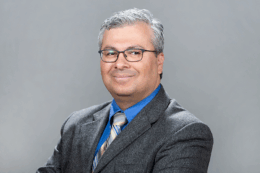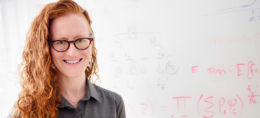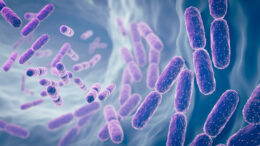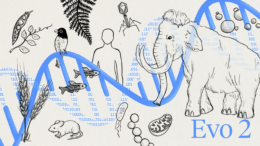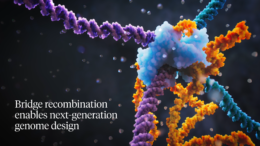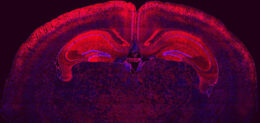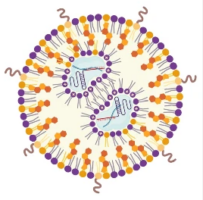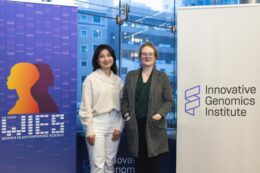Computational Biology

Computational biology uses the techniques of computer programmers and data scientists to approach biological problems. Common areas of focus are computer modeling of biological processes, protein structure and function analysis, genome mapping and function prediction, simulation and design of plant and microbial systems, and the creation of computational tools to facilitate these activities.
Computational biology plays a crucial role in drug discovery research, the design of microbial systems for medical and environmental applications, and the analysis of huge sets of biological data to find patterns and targets for medical treatment.
Research in computational biology has real-world impact in areas like:
The Environment, disease modeling, drug discovery, gene editing, microbiome, personalized medicine.
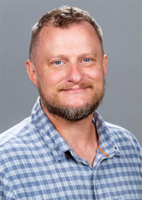
J. Christopher Anderson
For more information, see: https://andersonlab.qb3.berkeley.edu/
Anderson Lab develops new applications and tools for the Synthetic Biology community. Our goal is to create a computationally-driven platform for the design of genetic organisms that minimizes the uncertainties and errors of such projects. Our platform is built around a computational method for encapsulating the function of biomolecules based on precise chemical models. Our platform aggregates data from various sources, then develops synthesis and verification tools to automatically design engineered organisms with new functions, demonstrated with bacterium that produces acetaminophen.
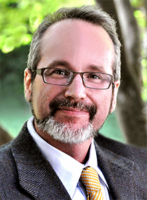
Adam Arkin
For more information, see: https://arkinlab.bio/
The Arkin Lab focus is how microbes transform, clean, and improve soils, soils that are currently degrading due to climate change, pollution, and poor water use. Near close-loops, low-energy, low-input biomanufacturing programs for food, pharmaceuticals, and building materials at “small village” scale, which are initially designed for a deep-space crewed Mars mission but have applications here on Earth for supporting sustainable agriculture. Another interest is to develop engineering approaches for microbiomes so we can control communities of microbes that drive the earth’s mineral cycles, support our plants and efficiency and stress responses, and impact the health and food-efficiency of a good many living creatures including ourselves.
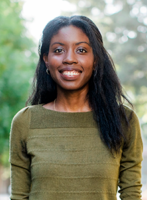
Leah Guthrie
For more information, see: https://www.theguthrielab.com/
The Guthrie lab investigates the principles that govern microbial metabolism and signaling in the context of kidney homeostasis and disease using mass spectrometry, chemoinformatics, and molecular biology approaches.

Teresa Head-Gordon
For more information, see: https://thglab.berkeley.edu/
The simultaneous revolutions in energy, molecular biology, nanotechnology and advanced scientific computing, is giving rise to new interdisciplinary research opportunities in computational science. The Head-Gordon lab embraces this large scope of science drivers through development of computational models and methodologies applied to molecular liquids, macromolecular assemblies, protein biophysics, and homogeneous, heterogeneous catalysis and biocatalysis. The development and application of complex chemistry models, accelerated sampling methods, coarse graining/multiscale techniques, and machine learning developed in her lab are widely disseminated through many community software codes that scale on high performance computing platforms.
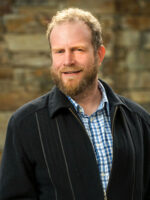
Ian Holmes
For more information, see: https://biowiki.org/IanHolmes
The Holmes Lab brings techniques from machine learning, statistical linguistics, phylogenetics, and web development to bear on the interpretation and analysis of genomic data. Examples include the application of context-free grammars to understanding DNA and RNA structure; the use of phylogenetic methods in genome annotation, and to detect recombination breakpoints; the development of machine learning algorithms for bioinformatics models; the reconstruction of insertion, deletion and transposition events in genome evolutionary histories; statistical algorithms for metagenomics species distribution analysis; and dynamic-HTML web applications for collaborative genomic data analysis.
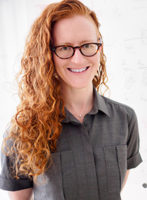
Liana Lareau
For more information, see: http://www.lareaulab.org/
A single genome produces the huge diversity of cells and tissues needed to make a human by regulating gene expression to turn on and off the right genes at the right times. The final, post-transcriptional steps of gene expression — RNA processing and translation — are essential to the proper outcome. Our goal is to understand how these layers of regulation are encoded in gene sequences and how disruptions to this regulation can cause disease. Our research uses machine learning and other computational methods, coupled with high-throughput experiments, to understand how post-transcriptional regulation leads to robust and flexible control of gene expression.
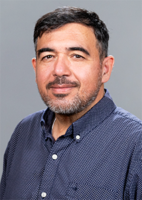
Mohammad Reza Kaazempur Mofrad
For more information, see: https://biomechanics.berkeley.edu/
Molecular and Multiscale Biomechanics; Bioinformatics and Computational Biology; Statistical Machine Learning; Computational Precision Health; Microbiome; Personalized Medicine
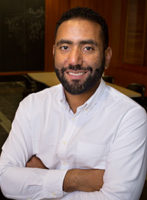
Aaron Streets
For more information, see: https://streetslab.berkeley.edu/
The Streets lab is interested in applying lessons from mathematics, physics, and engineering, to invent tools that help us dissect and quantify complex biological systems. Our goal is to uncover laws that govern the interactions of molecules inside the cell and the interactions between cells in a tissue or organism, by making precision measurements on single cells. In pursuit of this goal, we exploit three core technologies; microfluidics, microscopy, and genomics.
News About: Computational Biology
Four BioE Faculty Named 2025 Highly Cited Researchers
Professors Paul Adams, Adam Arkin, Patrick Hsu, and Jay Keasling have been recognized in the “2025 Highly Cited Researchers” list, meaning their work ranks in the top 1% of citations for their field and publication year in Clarivate’s Web of Science citation index
Taner Sen and Colleagues Sequence Complex Oat Pangenome
Adjunct Professor Taner Sen and his colleagues at the USDA and beyond have assembled and annotated the genomes of 33 wild and domesticated oat lines, along with an atlas of gene expression across 23 of these lines, which will enable future efforts to produce even more hardy and productive strains of the popular grain.
Lareau named MTI Innovator
Professor Liana Lareau is recognized for her revolutionary approach to treat retinitis pigmentosa and other dominant genetic diseases by combining CRISPR prime editing with machine learning.
The not-so-secret life of gut bacteria
Computational modeling from Mofrad Lab gives us a peek inside these important microbial communities.
AI can now model and design the genetic code for all domains of life with Evo 2
Research led by Professor Patrick Hsu has produced Evo 2, the largest AI model in biology to date, which can accurately predict the effects of all types of genetic mutations.
Bridge RNAs: ‘Holy Grail’ in Next-Gen Gene Editing Tech?
Patrick Hsu’s breakthrough discovery of bridge RNA gene editing tools is discussed on WebMD, with contributions from BioE alumnus Connor Tou.
Could a new medical approach fix faulty genes before birth?
Murthy lab and UC Davis have developed a unique mRNA delivery method for in-utero gene editing for neurodevelopmental conditions.
Thermostable Cas9 Enhances RNP Performance in Lung and Liver
Niren Murthy et al. have developed a more stable version of the Cas9 enzyme to improve delivery of CRISPR-Cas9 ribonucleoproteins (RNPs) for in vivo gene editing.
Faculty Focus on Leah Guthrie
Professor Leah Guthrie works to understand how the microbiome metabolites and proteins communicate with our human cells to influence our physiology and pathophysiology. Learn more about Guthrie in this interview with QB3.
Delcassian receives seed funding for cancer research
Professor Derfogail Delcassian has been awarded $1 million in non-dilutive seed funding to accelerate the commercialization of her work on targeted molecular therapies for hard-to-treat cancers.



